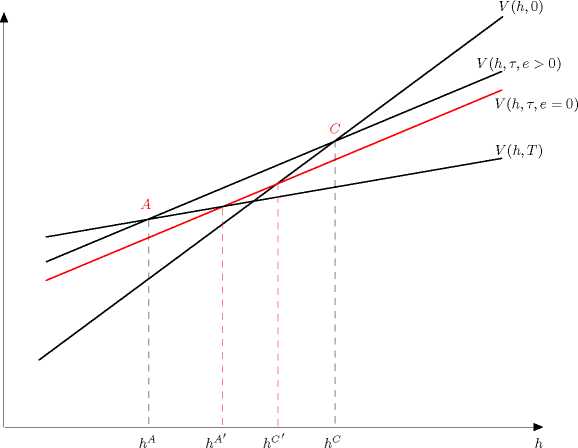Figure 2: Involuntary Unemployment

LTU STU Employed
invol. LTU invol. STU
retrain), the present-biased value of life-time income becomes
T-τ
Vτ-ι(h, τ) = b(1 - θ)h - kτ-1 ∙ c ∙ e + β ∑ δs(1 - θ)
s=1
(1 - d)h +
(S‘ ■)
(13)
implying that they will retrain if
c < β(1 — τ)δτ.
(14)
(15)
They will not retrain if the costs of retraining fulfill
β<δτ < ---< < δ>τ.
1-θ
If condition (15) holds, present-biased agents do not retrain when they lose eligibility for un-
employment benefits although they originally planned to use the STU spell to upgrade their
skills.
Figure 2 illustrates the consequences of a failed retraining episode depending on the worker’s
initial skill level. Because retraining was, in principle, worthwhile, failed retraining shifts life-
time income V(h,τ) downwards. At the upper end of the education spectrum, between h'C
and hC , we find those workers who would have preferred to be employed had they known
19
More intriguing information
1. La mobilité de la main-d'œuvre en Europe : le rôle des caractéristiques individuelles et de l'hétérogénéité entre pays2. TECHNOLOGY AND REGIONAL DEVELOPMENT: THE CASE OF PATENTS AND FIRM LOCATION IN THE SPANISH MEDICAL INSTRUMENTS INDUSTRY.
3. A methodological approach in order to support decision-makers when defining Mobility and Transportation Politics
4. The Shepherd Sinfonia
5. CURRENT CHALLENGES FOR AGRICULTURAL POLICY
6. The name is absent
7. Volunteering and the Strategic Value of Ignorance
8. Short- and long-term experience in pulmonary vein segmental ostial ablation for paroxysmal atrial fibrillation*
9. Do Decision Makers' Debt-risk Attitudes Affect the Agency Costs of Debt?
10. Visual Artists Between Cultural Demand and Economic Subsistence. Empirical Findings From Berlin.